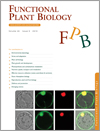
Functional Plant Biology
Volume 46 Number 9 2019
FP19014The effect of the elicitors on the steviol glycosides biosynthesis pathway in Stevia rebaudiana
Type 2 diabetes and obesity are two major risk factors for cardiovascular disease that are caused by over-consumption of sugar. Since artificial sweeteners have been shown to be harmful to health, natural extracts including steviol glycosides (SGs) are now considered the best substitute for sugar. We present new knowledge on the effect of elicitors on SGs biosynthesis, and show that an increase in plant yield can also increase these secondary metabolites.
FP19064The labile zinc pool in plant cells
 , Alexander V. Kartashov, Alexander V. Nosov, Artem A. Fomenkov and Vladimir V. Kuznetsov
, Alexander V. Kartashov, Alexander V. Nosov, Artem A. Fomenkov and Vladimir V. Kuznetsov
The dynamic aspects of zinc homeostasis in plant cells are poorly understood. We demonstrated for the first time that plant cells contain a pool of labile zinc complexes that control intracellular zinc availability and the physiological action of zinc ions. Our findings are crucial in understanding the mechanisms of intracellular zinc distribution and zinc regulatory action.
Terrestrial plants retain <5% of their root-acquired water, losing or using the rest through transpiration, cooling and drawing nutrients towards their roots. Using common bean (Phaseolus vulgaris), we established that soil nitrates, and not ammonium, regulated day- and night-time leaf water loss, which delivered soil nutrients to the roots. When leaf nitrate is limiting, plants elicit day- and night-time water loss, consequently gaining soil nutrients, but reduced their water loss when nitrate is replete.
FP18280Involvement of OpsLTP1 from Opuntia streptacantha in abiotic stress adaptation and lipid metabolism
Plant lipid transfer proteins are involved in diverse biological processes; however, most of them have been characterised from traditional plant models and little is known about homologues from other species. We characterised the function of OpsLTP1 gene from Opuntia streptacantha by OpsLTP1 overexpression in Arabidopsis, demonstrating an improvement in germination under abiotic stress, which was not observed in tolerance at seedling stage, in addition to alteration in lipid accumulation in seeds. These findings support the function of OpsLTP1 in abiotic stress responses suggesting possible mechanisms involving lipid metabolism.
FP19065Transcriptomic profiling revealed genes involved in response to cold stress in maize
Low temperature can decrease maize production by affecting seed germination and seedling growth, especially in early spring. We analysed chlorophyll fluorescence, membrane lipids, secondary metabolites and the transcriptome of two maize inbred lines (chilling-tolerant M54 and chilling-sensitive 753F) under cold stress. M54 showed better ability to protect the photosynthetic structures by synthesising unsaturated fatty acids and accumulating secondary metabolites. Our RNA sequencing dataset provides an important resource for future studies and breeding maize for improved cold tolerance.
This is the first comprehensive report of metabolites of Suaeda salsa. We found gallic acid exists only in the red phenotype, and was the main reason for leaf succulence, and two anthocyanins were responsible for red colour of red phenotype. Our research could provide references for the utilisation of this medicinal and edible plant in the future.
FP18266Novel OsGRAS19 mutant, D26, positively regulates grain shape in rice (Oryza sativa)
Grain size and shape are one of the most important components of grain yield in rice. D26 was cloned and identified as a positive regulator of grain size and shape through overexpression and CRISP/Cas9 editing. The functional characterisation of D26 suggests that D26 may be a potential tool for improving grain yield in crops.
FP18263Detergent-resistant microdomains (lipid rafts) in endomembranes of the wild halophytes
This work reports a progress in understanding of the membrane structure in mechanism of adaptation of halophytes. Based on the lipid analysis, evidence for the presence of rafts in chloroplast membranes of halophytes has been given for the first time; differences in the composition of raft-forming lipids in chloroplast and mitochondrial halophyte membranes differing in salt-resistance strategy have been elicited.



